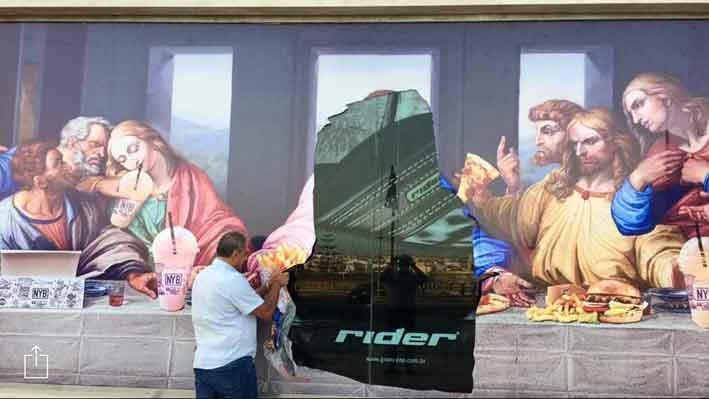Fast food chain founder Tommy Diacono has received several threats of violence, insults and disturbing messages after New York Best released an advert depicting Leonardo Da Vinci’s Last Supper.
The ad shows the twelve apostles and Jesus eating burgers, pizzas, fries and milkshakes instead of the original wine and bread, and can be seen from the Msida Skate Park just outside the University of Malta premises, where many students visit the several cafes and restaurants for their lunch break.
On Saturday evening, videos emerged of two men, later identified as Moviment Patrijotti Maltin leader Henry Battistino and election candidate Desmond Falzon, tearing down the image of Jesus from the advert. Asked whether he will be taking legal action against the two men for damaging private property, Diacono said that he had decided to “turn the other cheek”.
Never missing an opportunity to be tongue-in-cheek, which is characteristic of the fast-food restaurant owner, Diacono was making reference to advice given by Jesus Christ during the Sermon on the Mount, as described in the New Testament.
When the advert was unveiled some days ago, people immediately took to social media to express their often strong reactions. Some were in favour of seeing a different advertising concept and respected the fact that its intention, that of capturing people’s attention, worked like a charm.
Others took offence because they felt that New York Best did not need to use religion in order to further its own business goals. Some found the depiction of Jesus Christ with a pizza in front of him to be extremely offensive.
The 12-metre display elicited a strong reaction both from religious people and non-religious people. Asked about whether he was expecting news items and hot debates all over social media, Diacono said he was expecting some controversy but nowhere near this much.

Diacono spoke of the violent and disturbing messages he has received from members of the public through social media, adding that the advert does not depict religious figures doing anything immoral or controversial. They have not been shown to be drinking hard liquor, gambling, doing drugs or is sexually suggestive in anyway, they have been depicted eating a meal of burgers, fries, hot-dogs, pizzas and milkshakes.
He added that the Da Vinci’s original work was done in the spirit of producing a very contemporary and modern piece of artwork that already looked out of place at the time it was produced, so to speak. The painting depicts the 12 apostles and Jesus in a traditional, very rich looking palazzo from the 1400s.
Diacono said this was surely not the landscape from two millennia ago in the Middle East, and that when Da Vinci produced the masterpiece it was already pushing the boundaries in terms of modernity.

He even made reference to a famous Peruvian artist called Marcos Zapata (1710-1773) who was one of the last members of an art school teaching students how to paint religious works. He had recreated the Last Supper showing Jesus and his disciples gathering around a table laid with guinea pigs (traditional Peruvian food in the Andean region of South America). He has been praised for interpreting this famous work of art through the lens of his local Peruvian culture.
Taking a look at other ad campaigns where the Last Supper is depicted, two feature prominently. One was used by a betting company and the other was used by a French fashion house.
The betting company was an Irish one. Ireland is close to Malta in the sense that there are still dominant Catholic communities in its society. When one of Ireland’s betting companies used the image of the Last Supper to promote ‘fun and games’, the Advertising Standards Authority for Ireland ordered the company to remove the billboards and bus ads all around Ireland. Instead, the company had put white posters with red censorship squares with a reference to the website. It appears that the same Last Supper ad in other European countries did not stir up as much controversy.

People argued that beyond using a religious piece of artwork, the depiction was used to promote betting, something even more offensive because gambling and betting are generally viewed as troublesome vices that lead to many problems to a portion who become addicted.
The French fashion house on the other hand used the Last Supper to depict an almost all female version of the event, with Jesus depicted as female and the only male is shirtless, sitting on a woman’s lap. The man is being kissed on the torso by the woman he is sitting on. Religious groups found this aspect of the depiction to be more offensive, including the use of Christian symbols like the dove because ultimately the ad was being used for monetary gain.
The same advert ran in Paris and New York, and religious people there did not raise many qualms.
A local newsroom asked the Archbishop of Malta on his views of this fast-food advert, to which Monsignor Scicluna said that in his opinion, it was in ‘bad taste’ but failed to go into further detail about what specifically is offensive.
Diacono was yesterday quoted as saying that what he found to be extremely offensive was when the Moviment Patrijotti Maltin dished out pork sandwiches in Msida at the spot where practicing Muslims where carrying out their traditional call to prayer. Eating pork is against their religion and was a deliberately offensive move. Diacono pointed out the difference in public reactions between the two scenarios.